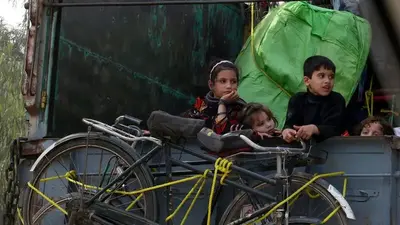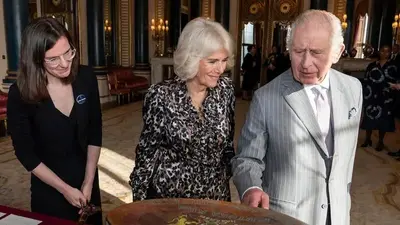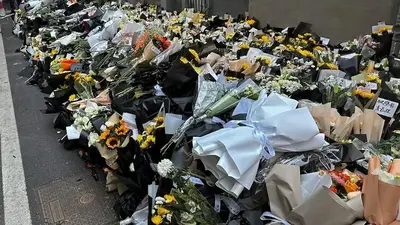World News
Adrift in the Atlantic, a boat of death and lost dreams
BELLE GARDEN, Tobago -- Around 6:30 a.m. on May 28, 2021, a couple of miles from Belle Garden Beach on the Caribbean island of Tobago, a narrow white-and-blue boat drifted onto the horizon. As it wobbled back and forth, fish gathered, feeding on the barnacles that had grown below the surface.
From a distance, it seemed no one was aboard. But as fishermen approached, they smelled death.
Inside were the decomposing bodies of more than a dozen Black men. No one knew where they were from, what brought them there, why they were aboard — and how or why they died. No one knew their names.
What is clear now, but wasn't then, is this: 135 days earlier, 43 people were believed to have left a port city across the ocean in Africa. They were trying to reach Spain’s Canary Islands, off Africa’s northwest coast.
They never arrived. Instead, they ended up here, on the other side of the Atlantic.
Half a world away, their families were looking for them.
___
For nearly two years, The Associated Press assembled puzzle pieces from across three continents to uncover the story of this boat — and the people it carried from hope to death.
The vessel that reached Tobago was registered in Mauritania, a large and mostly deserted country in northwest Africa nearly 3,000 miles (4,800 km) away. Evidence found on the boat — and its style and color as a typical Mauritanian “pirogue”— suggested the dead were likely African migrants who were trying to reach Europe but got lost in the Atlantic.
In 2021, at least seven boats appearing to be from northwest Africa washed up in the Caribbean and in Brazil. All carried dead bodies.
These “ghost boats” — and likely many others that have vanished — are in part an unintended result of years of efforts and billions of dollars spent by Europe to stop crossings on the Mediterranean Sea. That crackdown, along with other factors such as economic disruption from the pandemic, pushed migrants to return to the far longer, more obscure and more dangerous Atlantic route to Europe from northwest Africa via the Canaries instead.
Arrivals on the Atlantic route jumped from 2,687 in 2019 to more than 22,000 two years later, according to Spain’s Interior Ministry. But for those to arrive, many more must have departed, said Pedro Vélez, an oceanographer at the Spanish Institute of Oceanography. Vélez wasn’t surprised to learn of migrant boats appearing in the Caribbean – that is where floating devices dropped by scientists on the West African coast naturally drift.
“The sea conditions there are extremely harsh,” he said. “Extremely harsh.”
In 2021, at least 1,109 people died or disappeared trying to reach the Canaries, according to the International Organization for Migration, the deadliest on record. But that’s likely a fraction of the real death toll. The men in the Tobago boat, for example, are not included in this number.
Caminando Fronteras, a Spanish migrants’ rights organization, recorded more than 4,000 dead or missing on the Atlantic route in 2021, with at least 20 boats vanishing after departing from Mauritania.
These migrants are as invisible in death as they were in life. But even ghosts have families.
The AP investigation included interviews with dozens of relatives and friends, officials and forensic experts, as well as police documents and DNA testing. It found that 43 young men from Mauritania, Mali, Senegal and possibly other West African nations boarded the boat. AP has identified 33 of them by name.
They departed the Mauritanian port city of Nouadhibou in the middle of the night between Jan. 12 and 13, 2021. Clothing and DNA testing confirmed the identity of one of the bodies, bringing closure to one family and opening the way for others to seek the same.
The lack of political will and global resources to identify dead and disappeared migrants mean such resolutions, even partial ones, are rare. Each year, thousands of families wonder about the fate of loved ones who left their homes for Europe.
Few ever find out.
___
THE DISCOVERY
On the morning of May 28, 2021, Lance Biggart got a call from one of his fellow fishermen. A strange boat had appeared.
The 49-year-old Tobago native quickly reached his colleagues aboard his small but speedy boat, the Big Thunder. Dozens of fishermen joined him at the scene, filming the pirogue with their smartphones. Some continued fishing shiny mahi-mahi that had gathered around the corpses, life circling around death.
Biggart remembers being puzzled by how the boat could have survived Atlantic swells.
“A wave came, and the boat rocked so, so badly,” he recalls.
One of the dead men sat by the bow. The fishermen and police wondered if he was the last to die, moving away from the rest of the dead in the bottom of the boat.
Biggart and his colleague were asked by the coast guard to tow the pirogue back to shore. A tractor pulled the boat out of the water.
Men in white overalls carefully removed 14 bodies, three skulls and other large bones one by one, placing the remains in 15 bags. Some victims were missing limbs or heads. The sun had mummified some parts, while the salt and water at the bottom of the boat had putrified others.
Recovered from the boat were clothing, 1,000 West African CFA francs (under $2) and a few euros. Police also found half a dozen corroded cellphones with SIM cards from Mali and Mauritania. Tobago’s Cyber Crime Unit extracted a contact list from one of the SIMs.
Police in Trinidad and Tobago passed the numbers on to the Ministry of Foreign Affairs, which reached out several times to the government of Mauritania. They never got an answer, they said. Mauritania’s Foreign Ministry did not respond to phone calls or repeated requests for comment by email from the AP.
In the weeks that followed, customers stopped buying Biggart’s fish, fearing the dead were victims of some sort of sorcery. Others made unfounded speculations: Were they Ebola victims whose bodies had been thrown in the boat and set adrift?
As a man of the sea himself, Biggart felt responsible.
“I have a friend who went to sea and never came back,” he says. “I don’t know the people and them. But I know the family will be hurting.”
Yet months later, unable to identify the victims, police rebranded the criminal investigation into a “humanitarian” case. The remains were kept at the morgue of the Forensic Science Center in Trinidad.
To this day, there they sit.
___
A TRAIL OF CLUES
In 20 years as a forensic pathologist, Dr. Eslyn McDonald-Burris had never seen so many bodies arrive at the local mortuary in Tobago at once. Their apparent African descent reminded her of her enslaved ancestors.
“It’s kind of emotional for me, because I’m thinking why? What is happening here?” asked the soft-spoken Burris, who has since retired. “And then when I started looking at ocean currents. ... It’s the same currents that they used when they brought us here.”
She concluded they most likely died of “dehydration and hypothermia as a consequence of being lost at sea.”
Opening the body bags one by one, Burris was opening a small window into each person’s life. She looked for anything to help answer questions: Who were they? Where were they trying to go? What happened on the boat?
One had prayer beads with a crescent and a star, Muslim symbols. Another carried in his pocket a small label with Arabic writing of a water bottle from Mauritania. Yet another wore a watch on his left wrist, still running even though the time and date were wrong. “5:32 Sun,” it read.
Most shared similar traits — “that sort of tall, slender look, long thin face,” Burris says. Many wore several layers of clothing, common for seafaring migrants. A few wore dark green weather-proof jackets and pants, typically used both by fishermen in West Africa and by migrants seeking to avoid detection by port authorities.
As Burris pulled back the layers of clothing, she found soccer jerseys and shorts with the insignia of European teams as well as the Football Federation of the Islamic Republic of Mauritania. One man was dressed more formally, wearing a black button-down shirt with thin white stripes.
Another stood out to Burris. “A young man of African descent, slim build, dark complexion,” her autopsy report read.
He had short, dark-brown hair. His ears were “notably very small." His teeth were in good condition. His body was the most mummified of all, and his clothing was still relatively clean, suggesting he may have been one of the last to die.
“Down here we say a ‘sharp boy’,” Burris said, affectionately referring to his style.
He was found wearing distressed jeans, a Nike hoodie and a white patterned T-shirt underneath with some words on it — a lyric to a well-known Lionel Richie song.
It read: “HELLO, IS IT ME YOU’RE LOOKING FOR?”
___
AN AUNT IN FRANCE
Thousands of miles away, in the French city of Orléans, May Sow had all but given up hope of finding her nephew alive.
It was mid-January 2021, and Alassane Sow, 30, wasn’t answering his phone, leaving his family in both Mali and France desperate. May searched the internet for any trace of him.
A few days earlier, Alassane had told her over the phone that he was thinking of boarding a boat to Spain and, ultimately, to France to work, as some of his friends had done. His estranged father had also left for Spain. Smugglers charged 1,500 euros, and he had saved some money working as a security guard in Mauritania.
She thought it was a terrible idea. “It’s suicide,” she warned him. A family she knew from the Ivory Coast was mourning a relative who died trying to reach Europe.
Alassane said smugglers told him he would Travel on a sturdy boat with a proper engine, not the flimsy overcrowded rubber boats often seen capsizing in the Mediterranean. But even if he made it, she told him, he wouldn’t be allowed to work legally in France.
“When I go to Paris, I see people, migrants sleeping outside, under tents,” May recalled.
Alassane wouldn’t hear of it. After all, his French family had a good life with stable careers that allowed them to send money back to their village of Melga in Mali to support his mother.
Alassane’s grandparents had immigrated to France from the former colony decades ago, leaving their eldest daughter, Alassane’s mother, back in Mali. They had six more children in France, including May.
When May and her siblings tried to bring Alassane’s mother over, she was an adult no longer eligible for family reunification. She applied for a visa for France eight times, only to be rejected each time.
The Sow family in France had tried to support Alassane in two projects back in Mali, in livestock and in commerce. Both ultimately failed in part because of the impact of climate change and a fragile economy in a country plagued by years of conflict and political instability. The convenience store he opened with their help hardly made enough money to feed his family.
He ultimately moved to Mauritania to make roughly 75 euros a month, May said. That wasn’t enough.
May said the “kind, serious and respectful” young man never asked his French relatives for more money. Prosperity was in Europe, and the only way he could afford to get there was by boat.
“I think in his head, he thought he didn’t have a choice,” May said.
On the night between Jan. 12 and 13, 2021, he boarded a pirogue in Nouadhibou, Mauritania, headed to Spain’s Canary Islands, his family learned later.
After the initial silence came rumors, including one that his boat had been stopped in Morocco and the migrants sent to prison. May contacted a Malian community representative in Morocco to check prisons and morgues. No trace of Alassane.
She reached out to a page on Facebook called “Protect Migrants not Borders,” used by families of missing migrants to exchange information. That was when May realized her nephew was one of thousands disappearing each year en route to Europe.
Every day people posted about a missing person. Few were ever found.
Any tips she obtained were by word of mouth. There was no official information. She felt helpless.
Alassane’s mother, grandmother and wife held onto hope that he was alive, probably in prison somewhere, and couldn’t call. May was growing increasingly skeptical.
One night, she had a dream. She saw him dead with many people in the water, and she cried out for him.
In her nightmare, Alassane eventually opened his eyes but couldn’t speak. After that, she was sure they had shipwrecked. But she had no proof.
A few months later, her sister shared a news report about a Mauritanian boat found in Tobago with dead bodies inside. Then an AP reporter contacted her asking about the same. Could her nephew be among those?
He left in January. The boat was found in May. But except for the time frame, there was no evidence to suggest it was his boat. After all, the pirogues used by migrants departing Nouadhibou look the same.
___
FOLLOWING THE TRAIL
The contact list extracted from one of the SIM cards on a phone in the boat by authorities in Tobago contained 137 names.
The AP went down the list calling the numbers, asking those who replied if they knew anyone missing. One name kept coming up: Soulayman Soumaré, a taxi driver from Sélibaby in southern Mauritania, near the borders with Mali and Senegal.
The AP traveled to Sélibaby, a two-day drive from the fishing town of Nouadhibou on a strip of tarmac that cuts through a bleak desert, and spoke to dozens of relatives and friends to reconstruct what happened.
Soulayman had gone missing a year earlier, along with dozens of other young men from nearby villages. They had taken off from Nouadhibou on a boat carrying 43 people to the Canary Islands on the night of Jan. 12, 2021. It was the same boat that Alassane Sow boarded.
Forty-seven people were meant to have boarded the boat originally. Four men never got on.
One, who spoke on condition of anonymity, confirmed that he and dozens of other relatives, friends and acquaintances from Sélibaby and two nearby villages had traveled to Nouadhibou. There, they waited in apartments arranged by smugglers. He heard more people from a town on the border of Mali and Mauritania would also be getting on the boat.
Finally, on Jan. 12, the smugglers called. They would be leaving for Spain that night.
To avoid attracting authorities’ attention, the migrants split into smaller groups and left separately on different pirogues. They were to meet in the ocean and all transfer to a larger pirogue bound for the Canaries.
In Nouadhibou, hundreds of fishermen zip in and out all day and night, and port authorities struggle to inspect every boat for migrants. But when they saw four men allegedly going fishing without the typical dark green overalls, police stopped them.
Little did they know that their lives had just been spared.
___
FAMILIES, STILL WAITING
Just as few people in Tobago had ever heard of Mauritania before, families in Mauritania had never heard of Tobago. When shown the island on a map, with the Atlantic Ocean separating both nations, many gasped.
A few kilometers (miles) away from Sélibaby, on a dirt road dotted with goats, lies the village of Bouroudji, home to 11 of the missing young men. AP reporters shared the available information with their mothers: A Mauritanian boat had drifted to Tobago with 14 bodies. One phone retrieved from the boat was linked to the group their sons had traveled with. There were no known survivors.
“They’re all dead,” one mother exclaimed. She covered her face with her hands and left in despair.
Others hung onto hope. Until they saw their sons' bodies, the mothers said, they could still be alive. They pulled out their cellphones and shared photos of their sons with AP. Among them were two young men named Bayla Niang and Abdoulaye Tall.
Niang’s father, 71-year-old Ciré Samba Niang, said they were desperate for any information.
“There’s people who say they’ve died. There are people who say they are in prison,” he said. “There are others who say, nonsense.”
Niang said he wasn’t aware of his son’s plans. He blamed local unemployment along with better opportunities abroad. Many in his generation had also moved to Europe and made good money for Mauritanian standards.
“If one goes to Europe, in one or two years they’ll be able to build a house (in Mauritania), to buy a car,” Niang said. “The other person sees that and says, ‘I can’t stay here. I have to go, too.’”
In the nearby village of Moudji, the parents of Soulayman Soumaré and his cousins Houdou Soumaré and Djibi Koumé, who had also disappeared, struggled to get on with their lives. One mother was severely depressed and suffering from panic attacks, the villagers said.
“You cannot even talk because everyone is so upset,” said Oumar Koumé, the father of Djibi Koumé.
Like the mothers of Bouroudji, Koumé asked to see the bodies found in the boat that reached Tobago.
“If you see someone is dead in front of you, you know it is done. But if you don’t see it, every day there are rumors,” he said. “Your heart aches.”
Adama Sarré is a 46-year-old nurse and single mother. Her 25-year-old son, Cheikh Dioum, is among those who disappeared.
An introvert, Dioum would sometimes stay in his room for days, his mother said. He was upset, frustrated. He had repeatedly asked her for money to travel to Europe. But on her meager nurse’s salary, she had little to give him. She advised patience. She recalled telling him: “Cheikh, go slowly, go slowly. If I work and find money, I will get you a plane ticket and you will go.”
Dioum thought she was lying, she said. He left without saying goodbye.
“I call his phone, it doesn’t work,” she said. “I’m just sitting here.”
___
A SURVIVOR’S ACCOUNT
We may never know what happened to the men as they drifted from Nouadhibou to Tobago. But accounts from survivors of other shipwrecks in the Atlantic offer a clue.
Moussa Sako was rescued by the Spanish Air Force on April 26, 2021. Their boat was spotted by chance more than 310 miles (500km) from the Spanish island of El Hierro — “in the middle of nowhere,” as one of the rescuers described it.
They had set off 22 days earlier from Nouakchott, the capital of Mauritania. Only three of 63 people who boarded survived.
Like many on the boat, Sako, an asylum-seeker from Mali, had never seen the ocean. Four men with maritime experience, including a Senegalese “captain,” were in charge of reaching the Canaries. The voyage was to take four to five days.
They were packed like sardines, with Sako squeezed in the middle. The leaking gasoline and salt water in the bottom of the boat burnt their skin, making it painful to sit.
Not long after departing, they ran out of food and water. On the fourth day they ran out of fuel. To slow down their drift and be more visible to rescuers, they made a makeshift anchor by tying the engine and other heavy metal scraps to a rope.
With each day that passed, the boat drifted further. Tensions boiled into arguments. The smugglers, some said, had betrayed them.
More days passed. No rescue came. A growing number of people wanted to cut the rope loose to drift faster. Sako thought they would be better off staying still, where the sea was still calm and they could see some lights at night. But Sako was defeated in a vote. The rope was snipped.
Just as he feared, the wind took them to more agitated waters that poured over their boat. The next evening the first person died, a 20-year-old man. They washed and wrapped his body in Islamic tradition and prayed before throwing it overboard.
By the second week, three to four people were dying every day.
Some had hallucinations. One man jumped to his death thinking they had arrived. Others jumped to end their suffering. Sako, the Healthiest, tried to help the others.
“I had four full (layers of clothes) on me,” he recalled. “I would take one off and put it on them ... until I had only one.”
On day 18, he tried to get away from the rotting bodies. But they were everywhere. Only a handful of people were still alive. They hardly spoke.
Sako no longer feared death. He did worry about what would happen afterward.
“I wanted that even if I died, for people to recover (my body) and bury me,” Sako said. “If you disappear in the water, they can look for you for a hundred years.”
Finally, on day 22, a grey plane appeared in the sky above. Then came a helicopter. A rescuer dropped down and pulled Sako and the other two survivors from the corpse-ridden pirogue.
The bodies of 24 people were recovered and buried in the Canaries with case numbers instead of names. The remains of the other 36 were swallowed by the Atlantic.
___
(PARTIAL) ANSWERS
The number of people attempting the Atlantic crossing to the Canaries is falling again as Spain and the EU, with help from their African partners, try to close that migration route in a constant cat-and-mouse game. But the reasons pushing these men, women and children to go — a lack of jobs, poverty, violence, climate change — have only gotten worse.
One year after the 43 men departed Nouadhibou, the white-and-blue boat sat abandoned on the side of the road in Belle Garden, much like the case itself.
The clothing, objects and cellphones recovered from the boat and the bodies had been kept in the back of the Scarborough police station in Tobago. Even though it had been cleared for disposal, the officer in charge of storing police evidence had decided to hold onto the items “in case someone came looking for this some day.”
With latex gloves, the officer and an AP reporter cut open the sealed bags, pulling out the decaying evidence on the concrete floor to be documented.
There were the dirty soccer jerseys and shorts of Juventus, Paris St-Germain, Barcelona, Real Madrid and The Football Federation of Mauritania that Burris had noted in her autopsy reports. There were the dark green weatherproof coats and pants so many migrants wear during the crossing. There were the cellphones, so worn out that the devices fell apart at the slightest touch.
After days analyzing photos of the evidence like a puzzle, one T-shirt seemed familiar. In a photo shared by one of the mothers from the Mauritanian village of Bourdouji, 20-year-old Abdoulaye Tall is seen wearing a colorful T-shirt with words on it, but only parts of it were visible: “IS IT ... E ... YOU’RE.”
Suddenly, it came into focus. He was wearing the shirt that had struck Dr. Burris: “HELLO, IS IT ME YOU’RE LOOKING FOR?”
The AP shared its finding, along with photos of the T-shirt, with Tall’s father. He said he was grateful for the information, even though it shattered his hopes.
“It’s obvious he’s dead,” Djibi Tall said. “It’s God’s will.”
The AP also shared photos of the evidence collected in Tobago with other families of the missing in Mauritania, Mali, Senegal and France.
May Sow, the aunt in France, stared at the photos on her phone for days and stayed up late at night. One photo looked familiar: a black striped button-down shirt.
She went back to photos of her nephew from shortly before he disappeared. There it was — the same black striped shirt. He wore it on special occasions.
“I don’t think they had the right to bring things with them, so he must have worn his best clothes,” she said.
She reached out to one of Alassane’s friends in Mauritania who had accompanied him on the first part of the journey to the boat. He confirmed that Alassane had worn the striped shirt underneath a jacket with red pockets. Both were found on one of the bodies.
May Sow was already mourning the loss of her nephew, but her sister was still in denial. Sow reached out to the Red Cross in Senegal for help with a DNA test to confirm. But because Alassane’s mother was from Mali, they couldn’t help.
So in late June, the AP got a saliva sample sent from Alassane’s mother to the Forensics Science Center in Trinidad and Tobago.
Three months later, on Oct. 4, 2022, an email arrived in May Sow’s inbox.
“I regret to inform that the DNA sample result is a positive match.”
___
EPILOGUE
Alassane was buried after an Islamic funeral on March 3, 2023, at the Chaguanas Public Cemetery in Trinidad and Tobago. His family, unable to travel, held prayers in both his hometown in Mali and in France.
Of the 43 people believed to have boarded Alassane’s boat, only 14 bodies and skeletal remains were found in Tobago. The Red Cross has collected 51 DNA samples from family members of 26 missing migrants in hopes of identifying the other bodies at the Forensic Science Center in Trinidad. Those results aren’t yet known.
Some things are, in the end, unknowable. It’s possible — probable, even — that the world will never learn what exactly happened during the 135 days and nights that Alassane and the others spent adrift in the Atlantic.
But at least May Sow knows one thing now.
“At least, for my nephew, we have proof that it is him,” she said. “We can pray for him and believe that he is in a good place.”
___
AP senior producer Yesica Fisch in Dakar, Senegal contributed to this story.
-

 World News26m ago
World News26m agoWith Trump on Deck, Europe Reaches for Its Checkbook
-

 World News26m ago
World News26m agoAustralia’s Social Media Ban for Children Is Closer to Becoming Law. Here’s What to Know
-
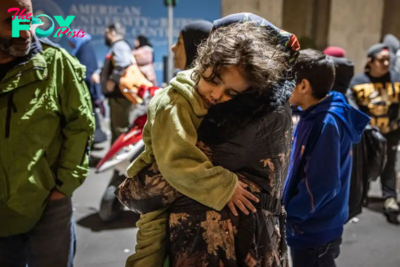
 World News15h ago
World News15h agoCeasefire Begins Between Israel and Hezbollah After Nearly 14 Months of Fighting
-

 World News21h ago
World News21h agoWill a Hezbollah-Israel Ceasefire Last?
-

 World News1d ago
World News1d agoAustralia Is Moving to Ban Children From Social Media. Will It Work?
-

 World News1d ago
World News1d agoE.U. Top Diplomat Says Israel Has ‘No Excuses’ to Refuse Lebanon Ceasefire
-
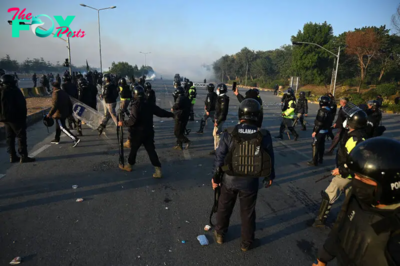
 World News1d ago
World News1d agoImran Khan Supporters Breach Locked Down Pakistan Capital as Protests Turn Deadly
-

 World News1d ago
World News1d agoTrump Threatens New Tariffs on Canada, Mexico, and China on First Day in Office






